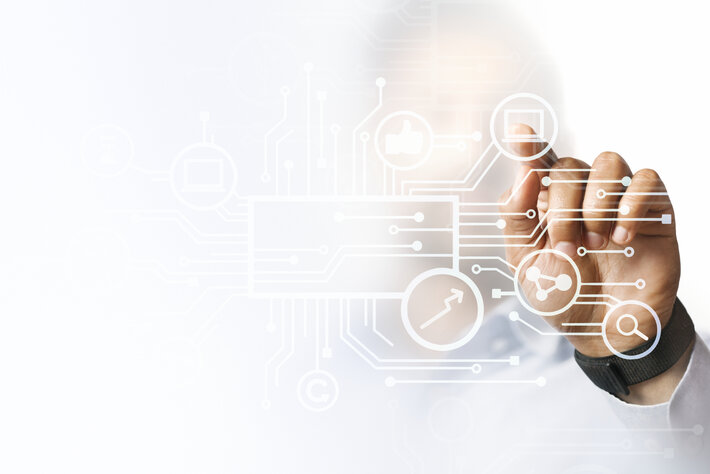In the UK, smart homes are mainly the preserve of the wealthy. In Germany however, the standards-based solution QIVICON has brought smart homes within reach of the wider public, and the company is now looking further afield.
Machine-to-machine (M2M) communication continues to grow and reach new markets. Globally there were, according to Machina Research, three billion M2M connections in 2013; by 2022 this number is set to increase six-fold. M2M has already made its mark in industry, but now M2M is extending its reach beyond the factory floor. Increasingly M2M is making headway in the living rooms, bedrooms and kitchens of ordinary consumers. Private individuals are controlling their lighting and heating or protecting their homes from break-ins by smartphone. In Europe alone, according to Berg Insight, about 1.5 million smart home systems of this kind were in use in 2013.
Moves by Apple and Google also highlight the promise for smart home solutions. This year Google acquired Nest Labs, a US manufacturer of smart thermostats and smoke alarms, following that with the purchase of start-up Dropcam, which sells internet-enabled cameras for home surveillance. Apple is hard on Google’s heels having already applied for a home automation patent.
Still a privilege of the wealthy
Smart homes are becoming more common in the UK. Consultants Strategy Analytics expect one in nine British households to be using at least one smart home system by the end of the year. They, however, will mainly be the homes of the rich. According to market research firm BSRIA, the luxury segment accounted for 70% of the UK’s smart home market in 2011. In 2012 the value of this market is said to have increased by a further 7%.
In contrast to the UK, smart homes are not just the preserve of high income households in Germany but, according to market researchers Fittkau & Maass, more than 75% of German internet users are interested in the technology. Germany faces a further problem, however, in that no standards have emerged and smart home solutions from different vendors are often not compatible with one another.
First cross-vendor platform
Management consultants Deloitte see platforms that allow consumers to combine products from multiple manufacturers as the future of the smart home. “The more partner companies integrate their offerings on a platform of this kind, the likelier customers are to find an application that corresponds to their requirements,” Deloitte says. “That is why, from the consumer’s point of view, open platforms are in principle advantageous.” The first smart home solution to fulfil this requirement is QIVICON.
QIVICON, from international telco, Deutsche Telekom, has been available in Germany since autumn 2013. With over 30 partner companies from different industries, QIVICON is the most open commercially available platform. It already supports several smart home wireless protocols, and more can be added. QIVICON is not limited to one terminal device platform. Partners, from large firms to start-ups, can develop apps for the operating system of their choice, such as iOS or Android. That is why QIVICON is increasingly becoming the smart home standard.
For its innovative approach and technology QIVICON has already received several awards, including one from management consultants Frost & Sullivan for being the most innovative smart home solution of 2014. Unlike many other smart home solutions, QIVICON is not a privilege limited to the wealthy, customers can buy starter packs from partner companies for as little as €269.
Wireless communication
QIVICON’s heart is its Home Base, which connects to the internet via any broadband connection. It communicates wirelessly with electrical equipment in the home such as wireless adapters, central heating thermostats, motion detectors and smoke alarms. Consumers can combine the devices as they see fit. QIVICON partner companies provide apps for smartphones, tablets or PCs to control and monitor the devices both at home and on the move.
The energy-conscious user, for example, can with a single click on a smartphone switch off all lights and other electrical devices such as the radio when going out. Further, if water leaks from the washing machine a water sensor can send an alert to the user’s smartphone. Burglars can be deterred – if a motion detector spots suspicious activity outside, the smart home control can switch on lighting and music to give the impression that someone is home. As QIVICON communicates wirelessly, installation requires neither walls to be ripped open nor cables to be laid, simplifying installation in older buildings and rented flats.
Open for new partners
“Every company, regardless of its industry and no matter whether it is a start-up or a large corporation, can use the QIVICON platform to develop solutions and apps of its own and offer them to its customers,” says Holger Knöpke, who leads Telekom’s Connected Home division. Each partner company, he explains, can define its own product, pricing, communication and sales strategy. Many of the 30+ QIVICON platform partners are conducting business internationally. They include Samsung, Philips, Miele, D-Link, Kärcher, Belkin and Telekom.
QIVICON itself may only be available in Germany now, but companies are already interested in introducing the QIVICON platform and partner products to the UK and across Europe. “At the moment we are receiving many enquiries from companies that would like to open up the smart home market with their products via our platform,” Knöpke says. “In future, international companies will be able to market their products as a part of their offering in the German market, for example. We cannot say right now when QIVICON will be on sale in other countries and to what extent.” Nonetheless, the prospects for smart home offerings in the UK are promising. Once users have stumped up the initial capital, they will even save money – on energy. After all, according to the UK Department of Energy & Climate Change, household electricity prices rose by nearly 6% between Q1 2013 and Q1 2014.










